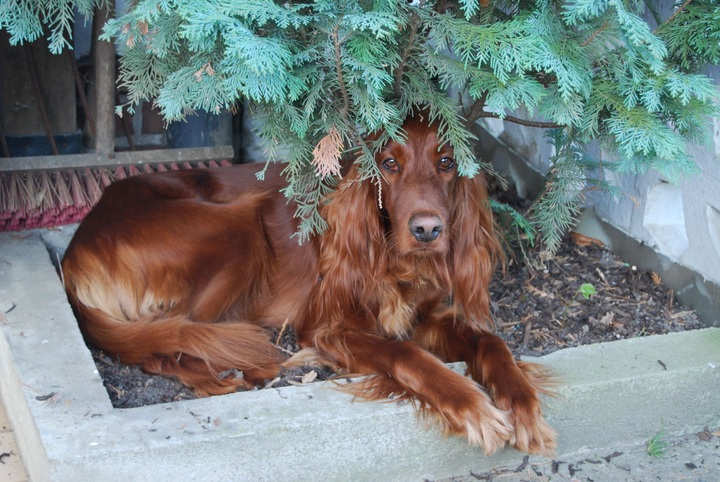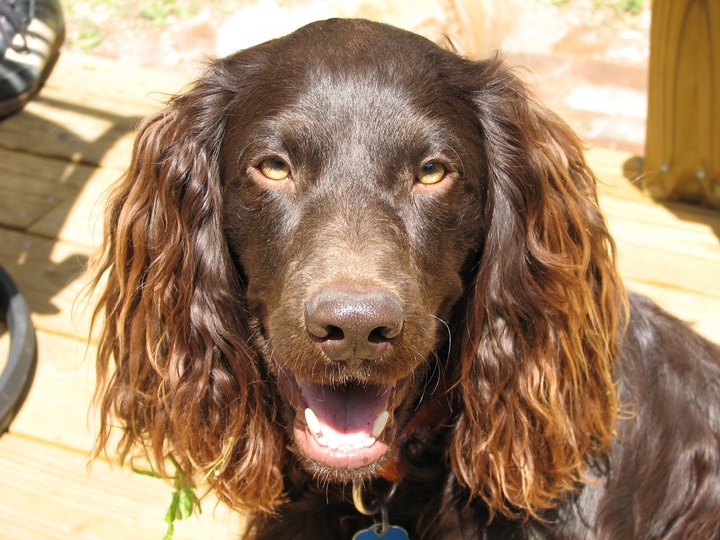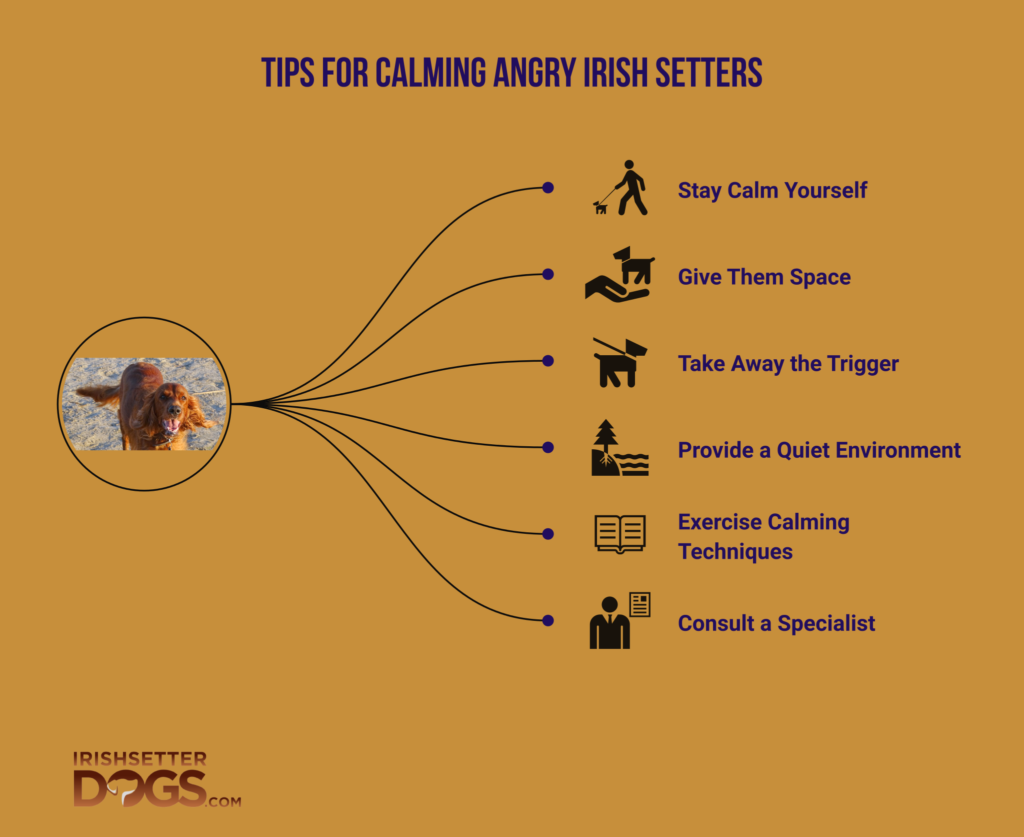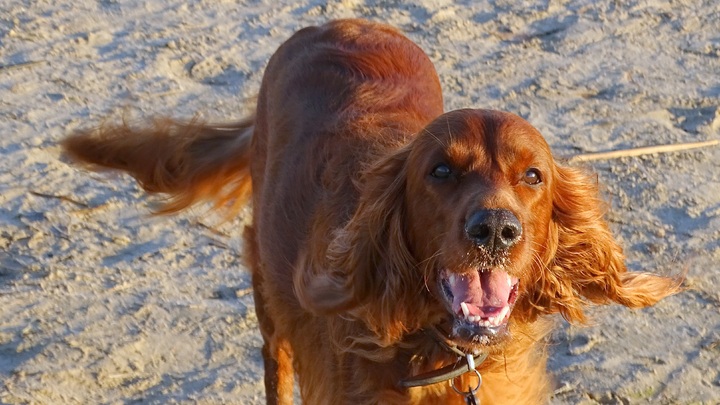Are you willing to know why is your Irish Setter always angry? The Irish Setter is a breed that many dog enthusiasts all over the globe have fallen in love with because of its striking red coat and elegant demeanor. The Irish Setter reflects an energetic and joyous disposition, given its remarkable looks and robust activity. Nevertheless, This breed is subject to the odd stereotype of a perpetually furious and unpleasant demeanor. Researchers and dog lovers alike have been intrigued by this interesting idea, spurring inquiries and a desire to learn more about this puzzling phenomenon.
The explanation that follows is based on generalizations and observations. Therefore, it may not apply to every Irish Setter. Even dogs of the same breed may behave quite differently. Therefore, evaluating each dog individually is important, considering their personalities, experiences, and upbringing. Keep reading for more knowledgeable ideas.
Irish Setter History and Background Information
It is thought that the breed known as the Irish Setter is a descendant of the English Setter, which was formerly bred with Irish water spaniels. Records indicate that the Setter first appeared in Ireland in the early 1700s and spread across the British Isles throughout the next century. The Irish Setter is renowned for possessing an exceptional sense of smell, which its owners use to detect birds for hunting.
Irish Setter dog breed was finally introduced to America in the 1800s, where they have since continued to work & hunt small game. The Irish Setter soon gained popularity as a show dog because of its striking looks and stoic hunting abilities. Their elongated form and chestnut hue give them a unique attractiveness unmatched by any other breed. Modern Irish Setters are prized more for their exquisite appearance than their sophisticated hunting abilities. The Irish Setter breed is the ideal companion for any home today since it is a loving and outgoing breed.
Reason Why Irish Setter Always Angry

Understanding why an Irish Setter may exhibit indications of rage or violence necessitates considering several variables, including the dog’s specific character, socialization, training, health, and surroundings. While Irish Setters are typically renowned for being kind and gentle, individual dogs may demonstrate various behavioral characteristics. Here’s a guide to assist you in understanding why an Irish Setter may look continuously furious, as well as potential solutions to the problem:
Assess the Dog’s Health.
Any probable health conditions must be ruled out before presuming that anger is the fundamental reason. Aggression or irritability might be caused by discomfort, pain, or underlying physical issues. Make an appointment with a veterinarian to safeguard your Irish Setter’s health.
Examine the Environment
Dogs are very aware of their environment. Examine the dog’s surroundings for recent changes that might create stress or anxiety. A new house, the entrance of a new family member and pet, or exposure to loud sounds may all cause dogs to experience unpleasant feelings. Create a peaceful and comfortable atmosphere for your Irish Setter by providing a quiet, safe place for them to retire to when required.
Examine Socialization and Training
Inadequate socialization or training may both lead to a dog’s behavioral troubles. Dogs not adequately socialized with different people, animals, and situations throughout their essential socialization phase may exhibit fear or hostility. Similarly, dogs with obedience training may need help to comprehend and react effectively to directions. Enroll your Irish Setter in positive reinforcement training programs and expose them to various social settings to help them gain confidence and improve their behavior.
Examine Previous Experiences
Traumatic events or previous unfavorable contacts might influence a dog’s behavior. If your Irish Setter has been abused, neglected, or mistreated in any way, this might lead to their rage or violence. Professional assistance from a certified dog behaviorist or trainer with expertise in dealing with aggressive dogs may be required to address and overcome these challenges.
Mental and Physical Stimulation
Irish Setters are a very energetic and bright breed that demands much mental and physical activity. A lack of exercise and mental stimulation may lead to irritation, expressing rage, or aggressiveness. Ensure your Irish Setter gets enough exercise daily by walking, playing, and cognitively challenging activities like puzzle toys or obedience training.
Seek Expert Assistance
If your Irish Setter’s rage remains or worsens despite your efforts, you should seek the advice of a professional dog behaviorist or trainer. They may examine your dog’s condition and provide a customized behavior modification strategy to handle his aggressiveness. To assist your dog in overcoming its rage, it may use strategies such as counter-conditioning, desensitization, or other positive reinforcement approaches.
Remember that dealing with dog rage or aggressiveness involves patience, persistence, and understanding. Handling the problem with a positive and caring attitude is critical, praising acceptable conduct rather than penalizing poor behavior. Please seek expert advice when required, as they may give specialized help customized to your Irish Setter’s requirements.
Sign That the Irish Setter Is Angry

When an Irish Setter is furious, they may display both physical and behavioral symptoms. Here are some possible signs that an Irish Setter is upset:
Snarling or Growling
The dog may make deep, rumbling noises or flash its fangs as a warning indication of hostility.
Raised Hackles
The hair on the back of the neck & shoulders may rise, suggesting increased arousal or hostility.
Stiff Body Posture
A furious Irish Setter may seem tight and strained with a stiff body position. The tail may be stiffly raised high or tucked between the knees.
Dilated Pupils
When a dog is agitated or stimulated, the pupils dilate, making the eyes look bigger.
Bared Teeth
When an Irish Setter is highly agitated or feels threatened, it may show its teeth in an aggressive display.
Lunging or Snapping
An angry Irish Setter may snap or lunge at the imagined danger or the cause of its rage in extreme circumstances. This activity indicates that it is preparing to fight or protect itself.
Unusual Vocalizations
Aside from growling, a furious Irish Setter may bark forcefully, excessively, or produce other unusual vocalizations.
It’s crucial to remember that dog aggressiveness should be taken seriously and cared for. Suppose you see symptoms of rage or aggressiveness in your Irish Setter. In that case, it’s best to seek the help of a professional dog trainer or behaviorist to address the underlying problems and ensure the dog and people around it’s safety.
Why Irish Setters Become Angry and How to Stop It
An angry Irish Setter, whether aimed towards you or another member of the family, a stranger, or another pet, might not only be terrifying, but it can also result in harm or legal action. However, although it may seem that your Irish Setter is biting you violently or exhibiting other aggressive behaviors out of nowhere, most dogs display aggressive behavior for one of five primary reasons: Your Irish Setter is sick, scared, possessive, overbearing, or frustrated.
Understanding why your Irish Setter is biting, snarling, or acting aggressively is the first step toward treating this very harmful habit. Too many owners believe that a violent dog has to be rehomed or killed. However, after you take measures to address the issues causing your dog to behave out, you will often discover that the hostility stops or is considerably reduced.
Why Do Irish Setters Act Angrily?

Knowing why your Irish Setter is behaving angrily is critical to devising the best strategy for stopping this distressing behavior. However, knowing the indications of canine aggressiveness is important since few dogs bite without first exhibiting increasing behaviors that signal an imminent attack.
Depending on the source and degree of the stimuli prompting the aggressiveness, a dog may exhibit all of these behaviors or just give a warning by snarling, growling, displaying violent body postures, or exhibiting its teeth without actually biting. Most of the time, your dog will act angrily for one of the five reasons listed below.
Fear
A terrified Irish Setter may quickly become violent. Most dogs only become violent when they perceive themselves to be in danger, are unable to flee, and feel the need to protect themselves. This might happen if a dog is forced into a corner with no way out or if it believes a hand held above its head implies it will be struck.
Suppose your Irish Setter is a rescue dog with unusually aggressive or scared behavior. In that case, it may have been mistreated, neglected, witnessed a traumatic incident, or was not adequately socialized as a puppy. Any information you get from the organization where you adopted the dog may assist you in determining the best course of action.
Rescue dogs may need obedience training with an instructor specializing in educating dogs that have been mistreated or haven’t been properly socialized. You can handle your Irish Setter’s fear independently in certain circumstances with training and patience. You may consult with a veterinarian to determine the best course of action. To avoid inciting this angry behavior, approach unfamiliar dogs cautiously (or, better yet, allow them to approach you). Train & socialize your Irish Setter to avoid fear in the future.
Injury and Illness
Certain medical disorders might make Irish Setters violent. Sickness or illness may be to blame if a dog that has never shown signs of hostility suddenly starts snarling, snapping, or biting. In dogs, pain is a very prevalent source of hostility. Your suddenly violent Irish Setter might suffer from an injury or sickness causing significant agony and stress. Arthritis, fractures, internal traumas, different cancers, and lacerations are all potential causes of pain.
Other disorders may damage your Irish Setters brain, resulting in irrational hostility. Cognitive impairment, brain disorders, or malignancies may trigger aggression. These issues are more common in older dogs, although they may develop at any age. If your dog exhibits sudden, inexplicable aggressiveness, consult your veterinarian before handling it as a behavioral issue.
You can be tempted to give your dog pain medicine, but this is anything you shouldn’t do. If your dog is ill, you’ll need to figure out what’s wrong with it before you start treating it. Don’t attempt to take things into your own hands until you’ve determined what you’re against. Only a veterinarian may suggest which treatments are best for your dog.
Possessiveness
Possession aggression, also known as resource guarding, happens when an Irish Setter becomes too protective of something. This is often toys, food, or some other valuable item. When someone approaches the food bowl or goes too near while he is chewing a favorite toy, a dog with possession aggression may growl.
A dog may also bite or act aggressively against a stranger who enters your house or property, which is the dog’s domain. This is a regular occurrence when dogs “hate the postal carrier” or bark fiercely at individuals just beyond the property border or fence. Aggression against other family pets is also often caused by resource guarding. Other animals in the house approaching the dog’s food dish, bed, or favorite toy may be growled at, snapped, or bit by certain dogs.
The level of hostility varies across dogs and between things. For example, if you sit down and massage your dog while he chews an elastic toy, he may turn and snap at you if you do the same while they chew a pig’s ear. Everything is determined by the dog’s value to each item or resource.
Dominance
Dogs may be aggressive to assert their authority. This is usually aimed against other dogs, but it may sometimes happen to humans. Recognizing dominance as an action, not a psychological attribute, is critical. Dogs are neither naturally dominating nor submissive. Some people may have a preference for one kind of conduct over another, although the circumstances usually dictate this.
Dogs that exhibit dominating behavior believe they must demonstrate their dominance over a situation. They may growl, snap, or bite when they believe their status is being threatened. Unfortunately, humans often misinterpret the source of canine aggressiveness as dominance-related behavior when another explanation exists. In truth, aggressively domineering conduct is much less prevalent than other aggressiveness.
Frustration
Frustration-driven aggression is also known as misdirected aggressiveness or barrier frustration. It happens when a dog is angry because he can’t get to something & vents his aggravation in another manner. This hostility is frequent in dogs that spend much of their time tied up, leashed, or behind a chain link fence.
A chained Irish Setter, for example, may spend the day attempting to reach a dog that lives across the path or in an adjacent yard. As the irritation mounts, the constrained Irish Setter generally barks & growls more furiously. The dog may vent its rage when the owner arrives by biting the owner. Redirected aggressiveness may also lead to the dog attacking another household pet, canine, or feline.
Make sure you read your dog’s hostility correctly. Before you presume you know what’s causing your Irish Setter’s violent behavior, rule out any health issues or fears. Otherwise, efforts at remedial action may exacerbate the condition. If you cannot identify the source of your Irish Setter’s hostility, hiring a professional dog trainer specializing in dogs’ anger might be beneficial. These experts have information and training techniques that may be quite helpful even with “lost causes” pets.
What to Do If an Angry Irish Setter Approaches You
Regardless of the breed, coming across an aggressive dog may be difficult and even hazardous. Putting your safety first while dealing with an angry Irish Setter or any other violent dog is critical. What to do is as follows:
Remain Calm
Dogs can detect fear and tension, which might make things worse. Keep your cool and refrain from making loud sounds or quick movements.
Avoid Approaching
Avoid establishing eye contact with the violent dog since it can be seen as challenging, and maintain a safe distance from it. Allow the dog some room and time to settle down.
Don’t Go Running
A dog’s prey drive may be sparked by running away from an aggressive dog and causing a pursuit. Instead, make an effort to take a calm, neutral step back.
Create a Barrier
Place anything between you and the dog, such as a tree, a parked vehicle, or a big bag, if possible. This may act as a physical barrier, blocking its journey.
Use a Commanding, Assured Voice
Say “stay” or “go home” to the dog forcefully and aggressively. The dog could be briefly startled or distracted. As a result, allowing you to withdraw quickly.
Find a Higher Place.
Try to locate an elevated surface, such as a bench or a vehicle hood, to create some space between you and the dog if it continues to approach you aggressively.
Defend Yourself.
Use whatever you can find as a shield if the dog strikes and you are at a loss for what to do. Your torso and face may be protected against bites with the use of a jacket, bag, or umbrella.
Ask for Assistance
Make a call for help after you are safely away from the violent dog. In order to report the occurrence and provide them with the dog’s location and description, get in touch with your neighborhood’s animal control or the police.
Always remember that avoiding unfamiliar or possibly hostile dogs and engaging in appropriate pet management will help to avoid such scenarios.
How To Handle Irish Setter’s Aggression
Treatment programs will begin with educating the Irish Setter on what you want them to accomplish. This is often accomplished via a positive reinforcement-based training approach. Tasks taught may vary depending on the particular Irish Setter and environment. Still, they may include training a dog to go to a containment area on demand, sit and stay for incentives, or get on or off furniture on command. Control devices, such as head halters and leashes, provide for control and safety without harsh, strong punishments while restricting the potential for aggressiveness.
Advanced activities may commence once fundamental control tasks have been learned and safety and aggression avoidance measures have been implemented. Classical counter-conditioning, desensitization, and exposure gradients are behavior modification strategies for problematic interactions. The Irish Setter is gradually exposed to formerly arousing stimuli at such low levels that arousal does not occur and is then granted for the proper response. At the same time, the Irish Setter is accountable for obeying new orders and is richly rewarded for making new, suitable judgments.
Tips for Calming Angry Irish Setters

Any agitated dog has to be calmed down. Therefore, patience, understanding, and a kind approach are essential. Here are some suggestions for soothing an irate Irish Setter:
Stay Calm Yourself
It’s crucial to maintain composure since dogs are sensitive to human emotions. The dog’s fury may get stronger if you feel upset or frustrated.
Give Them Space
Giving an Irish Setter adequate room to calm down when they are enraged is crucial. If you approach or crowd, the dog may feel intimidated and grow more aggressive.
Take Away the Trigger
If feasible, determine the cause of the rage and remove it from the dog’s surroundings. It may be a loud noise, a different species, or a particular item. The dog may become more relaxed if the trigger is removed.
Provide a Quiet Environment
Make a calm and quiet area where your Irish Setter may hide out when they’re angry. There should be no stress in this space and cozy bedding or a favorite blanket.
Exercise Calming Techniques
Give your Irish Setter activities that will help them relax and channel their energy. They may be successfully distracted and have their aggression reduced by taking long walks, playing quietly, using interactive toys, feeding puzzles, or engaging in gentle play.
Consult a Specialist
A certified dog trainer or animal behaviorist can assist you if your Irish Setter’s rage problems worsen or continue. They can evaluate the problem, provide pertinent recommendations, and create a behavior modification strategy tailored to your dog’s requirements.
Remember that every dog is different, so what works for one dog may not work for another. Be watchful, patient, and open to changing your strategy to fit your Irish Setter’s unique personality and triggers.
Frequently Asked Questions
Do Irish Setters Get Along With Children?
Irish Setters are wonderful family pets. They have the patience to cope with a small child, and their fun features go nicely with kids. This breed enjoys being the center of attention and requires constant proximity to its owners. To ensure that your pet behaves appropriately around youngsters, be sure to train them in obedience.
Do Irish Setters ever get hostile?
Due to their friendliness, don’t anticipate your Irish Setter to serve as a security dog. They don’t act aggressively and accept everyone. Irish setters are wise and attentive and get along with most humans and animals. They most definitely value being a member of the family.
When do Irish Setters become calmer?
Irish Setters take a while to develop. Some dogs mature by age two, while others spend their whole lives acting like puppies. Irish Setters are naturally curious and will investigate whatever they can get their hands on.
What attitude does an Irish Setter have?
The Irish Setter has a pleasant disposition, is loving, and is eager to please. He is an enthusiastic individual who likes having a task to complete. To ensure he is not bored with training, keep the approaches constant while making the sessions enjoyable.
Irish Setters, are they sensitive?
Irish Setters are sensitive dogs that develop relatively slowly and are prone to separation anxiety. Instead of being rich chestnut red, the progenitor breed of the Irish Setter was white with red markings.
Final Words
The issue of an Irish Setter being always angry must be viewed from a fair and impartial standpoint. It’s important to remember that it is inaccurate and unfair to generalize an individual dog’s conduct to a whole breed, even if Irish Setters can act aggressively or angrily. Do not forget that no breed is naturally hostile or violent. Since each dog is unique, several variables influence how they behave. An Irish Setter may flourish and display good qualities, just like any other breed, with the right care, training, and socialization.

